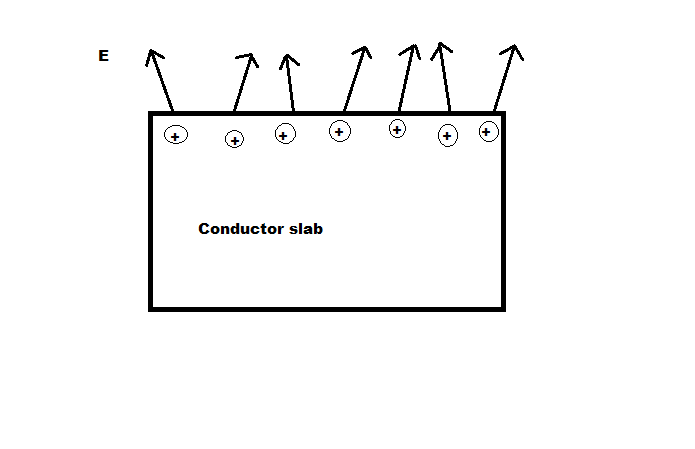A glass rod is given positive charge by rubbing it against silk. The glass rod is then rubbed against a metal slab (on an insulating stand), transferring the positive charge on the rod to the slab. Which of the following statements is true concerning the electric field at a point just outside the upper surface of the slab? It is zero because the electric field is always zero for isolated conductors. It is parallel to the surface. It is perpendicular to the surface. It can have nonzero components perpendicular to and parallel to the surface of the conductor. None of these
A glass rod is given positive charge by rubbing it against silk. The glass rod is then rubbed against a metal slab (on an insulating stand), transferring the positive charge on the rod to the slab. Which of the following statements is true concerning the electric field at a point just outside the upper surface of the slab? It is zero because the electric field is always zero for isolated conductors. It is parallel to the surface. It is perpendicular to the surface. It can have nonzero components perpendicular to and parallel to the surface of the conductor. None of these
College Physics
11th Edition
ISBN:9781305952300
Author:Raymond A. Serway, Chris Vuille
Publisher:Raymond A. Serway, Chris Vuille
Chapter1: Units, Trigonometry. And Vectors
Section: Chapter Questions
Problem 1CQ: Estimate the order of magnitude of the length, in meters, of each of the following; (a) a mouse, (b)...
Related questions
Question

Transcribed Image Text:A glass rod is given positive charge by rubbing it against silk. The glass rod is then
rubbed against a metal slab (on an insulating stand), transferring the positive charge
on the rod to the slab. Which of the following statements is true concerning the
electric field at a point just outside the upper surface of the slab?
It is zero because the electric field is always zero for isolated conductors.
It is parallel to the surface.
It is perpendicular to the surface.
It can have nonzero components perpendicular to and parallel to the surface of
the conductor.
None of these
It is zero because the electric fields of the positive charges will be cancelled out by the
electric fields of the electrons.
Expert Solution
Step 1

Just after charge is transfered it will start to spread out on the surface and the component of electric fields that are parrallel to surface will move the charges till the parrallel components cancel out and charges are spread out evenly and equlibrium is attained.
Step by step
Solved in 2 steps with 2 images

Knowledge Booster
Learn more about
Need a deep-dive on the concept behind this application? Look no further. Learn more about this topic, physics and related others by exploring similar questions and additional content below.Recommended textbooks for you

College Physics
Physics
ISBN:
9781305952300
Author:
Raymond A. Serway, Chris Vuille
Publisher:
Cengage Learning

University Physics (14th Edition)
Physics
ISBN:
9780133969290
Author:
Hugh D. Young, Roger A. Freedman
Publisher:
PEARSON

Introduction To Quantum Mechanics
Physics
ISBN:
9781107189638
Author:
Griffiths, David J., Schroeter, Darrell F.
Publisher:
Cambridge University Press

College Physics
Physics
ISBN:
9781305952300
Author:
Raymond A. Serway, Chris Vuille
Publisher:
Cengage Learning

University Physics (14th Edition)
Physics
ISBN:
9780133969290
Author:
Hugh D. Young, Roger A. Freedman
Publisher:
PEARSON

Introduction To Quantum Mechanics
Physics
ISBN:
9781107189638
Author:
Griffiths, David J., Schroeter, Darrell F.
Publisher:
Cambridge University Press

Physics for Scientists and Engineers
Physics
ISBN:
9781337553278
Author:
Raymond A. Serway, John W. Jewett
Publisher:
Cengage Learning

Lecture- Tutorials for Introductory Astronomy
Physics
ISBN:
9780321820464
Author:
Edward E. Prather, Tim P. Slater, Jeff P. Adams, Gina Brissenden
Publisher:
Addison-Wesley

College Physics: A Strategic Approach (4th Editio…
Physics
ISBN:
9780134609034
Author:
Randall D. Knight (Professor Emeritus), Brian Jones, Stuart Field
Publisher:
PEARSON